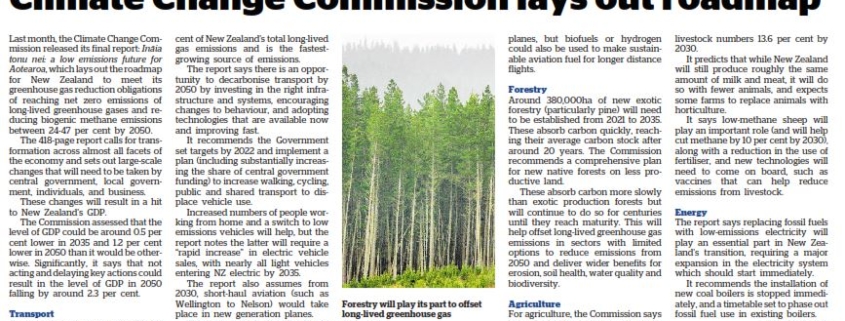Sustainable Business: Climate Change Commission lays out roadmap
Sustainable Business: Climate Change Commission lays out roadmap
Last month, the Climate Change Commission released its final report: Ināia tonu nei: a low emissions future for Aotearoa, which lays out the roadmap for New Zealand to meet its greenhouse gas reduction obligations of reaching net zero emissions of long-lived greenhouse gases and reducing biogenic methane emissions between 24-47 per cent by 2050.
The 418-page report calls for transformation across almost all facets of the economy and sets out large-scale changes that will need to be taken by central government, local government, individuals, and business.
These changes will result in a hit to New Zealand’s GDP.
The Commission assessed that the level of GDP could be around 0.5 per cent lower in 2035 and 1.2 per cent lower in 2050 than it would be otherwise. Significantly, it says that not acting and delaying key actions could result in the level of GDP in 2050 falling by around 2.3 per cent.
Transport
Transport makes up almost 33 per cent of New Zealand’s total long-lived gas emissions and is the fastest-growing source of emissions.
The report says there is an opportunity to decarbonise transport by 2050 by investing in the right infrastructure and systems, encouraging changes to behaviour, and adopting technologies that are available now and improving fast.
It recommends the Government set targets by 2022 and implement a plan (including substantially increasing the share of central government funding) to increase walking, cycling, public and shared transport to displace vehicle use.
Increased numbers of people working from home and a switch to low emissions vehicles will help, but the report notes the latter will require a “rapid increase” in electric vehicle sales, with nearly all light vehicles entering NZ electric by 2035.
The report also assumes from 2030, short-haul aviation (such as Wellington to Nelson) would take place in new generation planes.
This was modelled with electric planes, but biofuels or hydrogen could also be used to make sustainable aviation fuel for longer distance flights.
Forestry
Around 380,000ha of new exotic forestry (particularly pine) will need to be established from 2021 to 2035. These absorb carbon quickly, reaching their average carbon stock after around 20 years. The Commission recommends a comprehensive plan for new native forests on less productive land.
These absorb carbon more slowly than exotic production forests but will continue to do so for centuries until they reach maturity. This will help offset long-lived greenhouse gas emissions in sectors with limited options to reduce emissions from 2050 and deliver wider benefits for erosion, soil health, water quality and biodiversity.
Agriculture
For agriculture, the Commission says New Zealand needs to reduce its livestock numbers 13.6 per cent by 2030.
It predicts that while New Zealand will still produce roughly the same amount of milk and meat, it will do so with fewer animals, and expects some farms to replace animals with horticulture.
It says low-methane sheep will play an important role (and will help cut methane by 10 per cent by 2030), along with a reduction in the use of fertiliser, and new technologies will need to come on board, such as vaccines that can help reduce emissions from livestock.
Energy
The report says replacing fossil fuels with low-emissions electricity will play an essential part in New Zealand’s transition, requiring a major expansion in the electricity system which should start immediately.
It recommends the installation of new coal boilers is stopped immediately, and a timetable set to phase out fossil fuel use in existing boilers.



